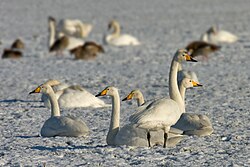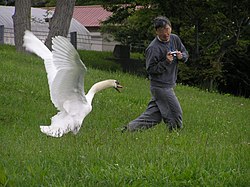Swan
A swan (Cygnini) is a kind of water bird, from the genera Cygnus and Coscoroba. They are in the subfamily Anserinae, in the family Anatidae, which also includes geese and ducks.
| Swans | |
|---|---|

| |
| Mute swans (Cygnus olor) | |
| Scientific classification | |
| Kingdom: | |
| Phylum: | |
| Class: | |
| Order: | |
| Family: | |
| Subfamily: | |
| Genus: | Cygnus
|
Many swans live in colder places, such as northern Europe, Asia and North America. They live on water. They swim on top of the water and eat plants off the bottom of ponds, lakes, or oceans. They also eat insects and other small animals. A baby swan is called a cygnet.
Swans are tough, strong birds who will stand no nonsense from dogs or cats. They may open their wings as a warning, but from then on a person is advised to keep clear. Swans are highly protective of their nests. They will attack anything they see as a threat to their chicks, including humans.
Description
The swans are some of the largest flying birds. They are large in size and have large feet and long necks. The males are usually bigger and heavier than females. The mute swan, trumpeter swan, and whooper swan are the largest swans. They can be over 1.5m (60 inches) long. They can weigh over 15kg (33 pounds). Their wingspans (this means the length of both wings) can be almost 3m (10 ft).
Most swans are white. They are found in the Northern Hemisphere. This means they are found in Europe, Asia and North America. However, the black swan is black with a red beak. It lives in Australia. The black necked swan has white flight feathers, and black outer feathers. It lives in South America. They also have a small area of skin between the eyes and beak that has no feathers. This area can be different colors, such as yellow (for example, on a Bewick's swan) or orange (for example, on a mute swan).
Wild swans migrate. They spend the cold part of the year eating and getting fat in one place and move to a warmer place to lay eggs and raise chicks, called cygnets.[1]
The coscoroba swan is different to the other swans. Some scientists think it is more like a duck or a goose. It is the smaller than the other swans. This swan lives in South America.
Climate change
Bewick's swans used to spend a lot of time in Ireland and Britain and the Netherlands, but scientists say they have been moving east into Germany. They spend less time in their winter feeding grounds than they did in 1970. Scientists say they are following the changes in temperature in Europe. The scientists found that individual swans do not change where they like to go during their own lifetimes. Instead, different generations of swans go to different places from their parents and grandparents.[1][2]
Taxonomy
- Genus Cygnus
- Black swan (Cygnus atratus)
- New Zealand swan (Cygnus atratus sumnerensis) †
- Trumpeter swan (Cygnus buccinator)
- Bewick's swan (Cygnus bewickii)
- Whistling swan (Cygnus columbianus)
- Whooper swan (Cygnus cygnus)
- Black-necked swan (Cygnus melancoryphus)
- Mute swan (Cygnus olor)
- Black swan (Cygnus atratus)
- Genus Coscoroba
Swan Media
An adult mute swan (Cygnus olor) with cygnets in Vrelo Bosne, Sarajevo, Bosnia and Herzegovina
A mute swan landing on water. Due to the size and weight of most swans, large areas of open land or water are required to successfully take off and land.
Whooper swans migrate from Iceland, Greenland, Scandinavia, and northern Russia to Europe, Central Asia, China, and Japan
Swans with nest and eggs at Lake Constance
Courting swan on the Danube river
Mute swan threatens a photographer in Toyako, Japan
References
- ↑ 1.0 1.1 Netherlands Institute of Ecology (June 12, 2020). "Where have the swans gone?". Press release. https://nioo.knaw.nl/en/press/where-have-swans-gone. Retrieved June 12, 2020.
- ↑ Rascha J. M. Nuijten; Kevin A. Wood; Trinus Haitjema; Eileen C. Rees; Bart A. Nolet (June 9, 2020). "Concurrent shifts in wintering distribution and phenology in migratory swans: Individual and generational effects". Global Change Biology. 26 (8): 4263–4275. Bibcode:2020GCBio..26.4263N. doi:10.1111/gcb.15151. PMC 7384179. PMID 32515077. S2CID 219549516.
| Wikispecies has information on: Cygnus. |
| Wikispecies has information on: Coscoroba. |
| Wikimedia Commons has media related to Lua error in Module:Commons_link at line 62: attempt to index field 'wikibase' (a nil value).. |








